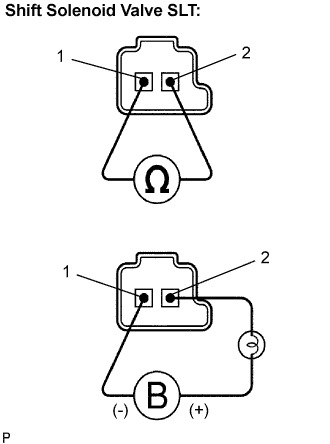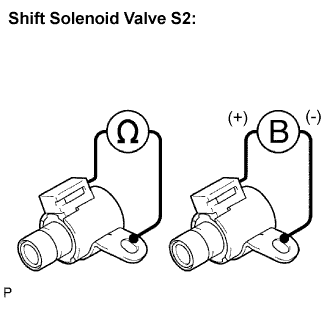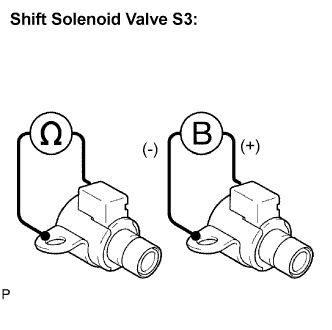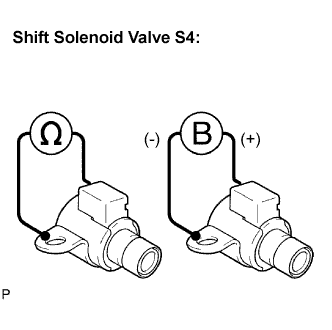Dtc P2714 Pressure Control Solenoid D Performance (Shift Solenoid Valve Slt)
SYSTEM DESCRIPTION
MONITOR DESCRIPTION
INSPECTION PROCEDURE
CHECK OTHER DTCS OUTPUT (IN ADDITION TO DTC P2714)
INSPECT SHIFT SOLENOID VALVE SLT
INSPECT SHIFT SOLENOID VALVE S1
INSPECT SHIFT SOLENOID VALVE S2
INSPECT SHIFT SOLENOID VALVE S3
INSPECT SHIFT SOLENOID VALVE S4
INSPECT TRANSMISSION VALVE BODY ASSEMBLY
INSPECT TORQUE CONVERTER CLUTCH ASSEMBLY
DTC P2714 Pressure Control Solenoid "D" Performance (Shift Solenoid Valve SLT) |
SYSTEM DESCRIPTION
The linear solenoid valve (SLT) controls the transmission line pressure for smooth transmission operation based on signals from the throttle position sensor and the vehicle speed sensor. The ECM adjusts the duty cycle of the SLT solenoid valve to control hydraulic line pressure coming from the primary regulator valve. Appropriate line pressure assures smooth shifting with varying engine outputs. (*): Duty RatioThe duty ratio is the ratio of the period of continuity in one cycle. For example, if A is the period of continuity in one cycle, and B is the period of non-continuity, thenDuty Ratio=A/(A+B) x 100 (%)
(*): Duty RatioThe duty ratio is the ratio of the period of continuity in one cycle. For example, if A is the period of continuity in one cycle, and B is the period of non-continuity, thenDuty Ratio=A/(A+B) x 100 (%)DTC No.
| DTC Detection Condition
| Trouble Area
|
P2714
| ECM detects a malfunction on SLT (ON side) according to the revolution difference of the turbine and the output shaft, and also by the oil pressure. (2-trip detection logic)
| - Shift solenoid valve SLT remains open or closed
- Shift solenoid valve S1, S2, S3 or S4 remains open or closed
- Gear 6 incorrect ratio (reverse sequence valve) or 1-2 shift valve is stuck
- Valve body is blocked
- Automatic transmission (clutch, brake or gear, etc.)
|
MONITOR DESCRIPTION
The ECM calculates the amount of heat absorbed by the friction material based on the difference in revolution (clutch slippage) between the turbine and output shaft. The ECM turns on the MIL and outputs this DTC when the amount of heat absorption exceeds the specified value.When the shift solenoid valve SLT remains on, oil pressure goes down and clutch engagement force decreases.NOTE: If you continue driving under these conditions, the clutch will burn out and the vehicle will no longer be drivable.
INSPECTION PROCEDURE
- HINT:
- Performing the intelligent tester Active Test allows relay, Vacuum Switching Valve (VSV), actuator and other items to be operated without removing any parts. Performing the Active Test early in troubleshooting is one way to shorten labor time.
- The Data List can be displayed during the Active Test.
Warm up the engine.
Turn the engine switch off.
Connect the intelligent tester to the DLC3.
Turn the engine switch on (IG) position.
Turn on the tester.
Select the item "Enter / Power train / ECT / Active Test".
Follow the instructions on the tester and read the Active Test.
Item
| Test Details
| Diagnostic Note
|
Control the Line Pressure Up *
| [Test Details]
Operate the shift solenoid SLT and raise the line pressure.
[Vehicle Condition]
- Vehicle Stopped.
- IDL: ON
- HINT:
- OFF: Line pressure up (When the active test of "Control the Line Pressure Up" is performed, the ECM commands the SLT solenoid to turn off).
- ON: No action (normal operation)
| -
|
*: "Control the Line Pressure Up" in the ACTIVE TEST is performed to check the line pressure changes by connecting the SST to the automatic transmission, which is used in the HYDRAULIC TEST (Click here) as well.
- HINT:
- The pressure values in ACTIVE TEST and HYDRAULIC TEST are different from each other.
- Normally, the line pressure detected in the ACTIVE TEST is approximately half of the value detected in the HYDRAULIC TEST's stall test.
| 1.CHECK OTHER DTCS OUTPUT (IN ADDITION TO DTC P2714) |
Connect the intelligent tester to the DLC3.
Turn the engine switch on (IG) position.
Turn on the tester.
Select the item "Power train / ECT / DTC / Current or Pending".
Read the DTCs using the intelligent tester.
- Result:
Display (DTC output)
| Proceed to
|
Only "P2714" is output
| A
|
"P2714" and other DTCs
| B
|
- HINT:
- If any other codes besides "P2714" are output, perform troubleshooting for those DTCs first.
| 2.INSPECT SHIFT SOLENOID VALVE SLT |
Remove the shift solenoid valve SLT.
Measure the resistance according to the value(s) in the table below.
- Resistance:
Tester Connection
| Specified Condition
20°C (68°F)
|
1 - 2
| 5.0 to 5.6 Ω
|
Connect the positive (+) lead with a 21 W bulb to terminal 2 and the negative (-) lead to terminal 1 of the solenoid valve connector, then check the movement of the valve.
- OK:
- The solenoid makes an operating sound.
| | REPLACE SHIFT SOLENOID VALVE SLT |
|
|
| 3.INSPECT SHIFT SOLENOID VALVE S1 |
Remove the shift solenoid valve S1.
Measure the resistance according to the value(s) in the table below.
- Resistance:
Tester Connection
| Specified Condition
20°C (68°F)
|
Solenoid Connector (S1) - Solenoid Body (S1)
| 11 to 15 Ω
|
Connect the positive (+) lead to the terminal of the solenoid connector, and the negative (-) lead to the solenoid body.
- OK:
- The solenoid makes an operating sound.
| | REPLACE SHIFT SOLENOID VALVE S1 |
|
|
| 4.INSPECT SHIFT SOLENOID VALVE S2 |
Remove the shift solenoid valve S2.
Measure the resistance according to the value(s) in the table below.
- Resistance:
Tester Connection
| Specified Condition
20°C (68°F)
|
Solenoid Connector (S2) - Solenoid Body (S2)
| 11 to 15 Ω
|
Connect the positive (+) lead to the terminal of the solenoid connector, and the negative (-) lead to the solenoid body.
- OK:
- The solenoid makes an operating sound.
| | REPLACE SHIFT SOLENOID VALVE S2 |
|
|
| 5.INSPECT SHIFT SOLENOID VALVE S3 |
Remove the shift solenoid valve S3.
Measure the resistance according to the value(s) in the table below.
- Resistance:
Tester Connection
| Specified Condition
20°C (68°F)
|
Solenoid Connector (S3) - Solenoid Body (S3)
| 11 to 15 Ω
|
Connect the positive (+) lead to the terminal of the solenoid connector, and the negative (-) lead to the solenoid body.
- OK:
- The solenoid makes an operating sound.
| | REPLACE SHIFT SOLENOID VALVE S3 |
|
|
| 6.INSPECT SHIFT SOLENOID VALVE S4 |
Remove the shift solenoid valve S4.
Measure the resistance according to the value(s) in the table below.
- Resistance:
Tester Connection
| Specified Condition
20°C (68°F)
|
Solenoid Connector (S4) - Solenoid Body (S4)
| 11 to 15 Ω
|
Connect the positive (+) lead to the terminal of the solenoid connector, and the negative (-) lead to the solenoid body.
- OK:
- The solenoid makes an operating sound.
| | REPLACE SHIFT SOLENOID VALVE S4 |
|
|
| 7.INSPECT TRANSMISSION VALVE BODY ASSEMBLY |
- OK:
- There are no foreign objects on each valve.
| | REPAIR OR REPLACE TRANSMISSION VALVE BODY ASSEMBLY |
|
|
| 8.INSPECT TORQUE CONVERTER CLUTCH ASSEMBLY |
- OK:
- The torque converter clutch operates normally.
| | REPLACE TORQUE CONVERTER CLUTCH ASSEMBLY |
|
|
| OK |
|
|
|
| REPAIR OR REPLACE AUTOMATIC TRANSMISSION ASSEMBLY |
|





